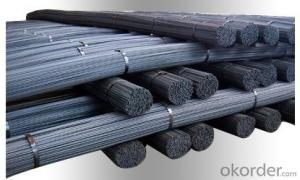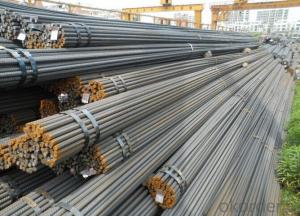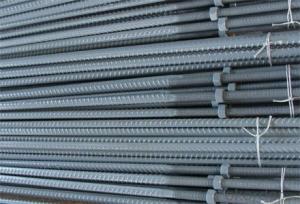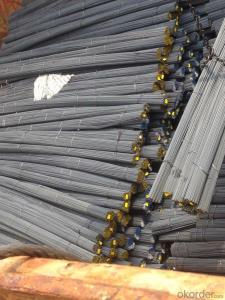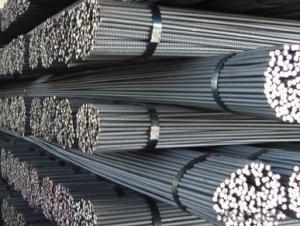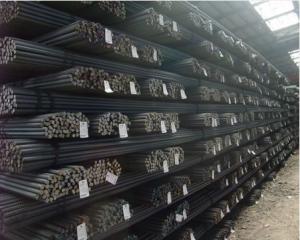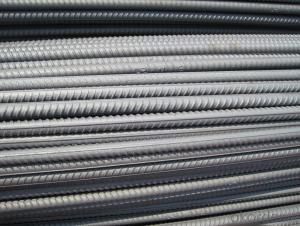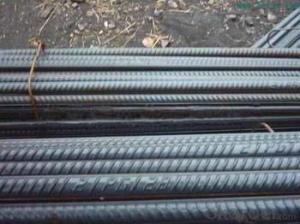GR40 deformed steel bar for construction
- Loading Port:
- Tianjin
- Payment Terms:
- TT OR LC
- Min Order Qty:
- 25 m.t.
- Supply Capability:
- 10000 m.t./month
OKorder Service Pledge
OKorder Financial Service
You Might Also Like
Product Description:
Theoretical weight and section area of each diameter as below for your information:
Diameter(mm) | Section area (mm²) | Mass(kg/m) | Weight of 12m bar(kg) |
6 | 28.27 | 0.222 | 2.664 |
8 | 50.27 | 0.395 | 4.74 |
10 | 78.54 | 0.617 | 7.404 |
12 | 113.1 | 0.888 | 10.656 |
14 | 153.9 | 1.21 | 14.52 |
16 | 201.1 | 1.58 | 18.96 |
18 | 254.5 | 2.00 | 24 |
20 | 314.2 | 2.47 | 29.64 |
22 | 380.1 | 2.98 | 35.76 |
25 | 490.9 | 3.85 | 46.2 |
28 | 615.8 | 4.83 | 57.96 |
32 | 804.2 | 6.31 | 75.72 |
36 | 1018 | 7.99 | 98.88 |
40 | 1257 | 9.87 | 118.44 |
50 | 1964 | 15.42 | 185.04 |
Usage and Applications of Construction
1. Construction steel round bar is mostly used for straight bundles supply, and used for steel, bolts and various mechanical parts. While the bigger round bar, or more than 25mm hot rolled bar, is mainly for the manufacture of mechanical parts or for seamless steel billet.
2. Steel round bar is used in construction and a large number of architectural and engineering structures.
3. Besides, we can supply some especial material steel round bar that can be used for main shaft of steamer, hummer shank, with big section and supper force.
Packaging & Delivery
Packaging Detail: All goods are packed in bundle with steel strips and shipped by break bulk vessel or container (depend on target market and different ports)
Delivery Detail: 45 days
Trade terms: FOB, CFR, CIF
MOQ: 25 tons per specification; we can negotiate the quantity if the specification is normal or we have stock of one specification.
Weight: Theprice invoicing on theoretical weight basis or actual weight basis depends on customer’s request.
Shipment: The shipment of bulk break or container is depends on customer’s request and the situation of the port of destination.
Documents given: Full set of original clean on board bill of lading; Original signed commercial invoice; Original packing list; Policy of insurance; Certificate of origin and what the target market needs.
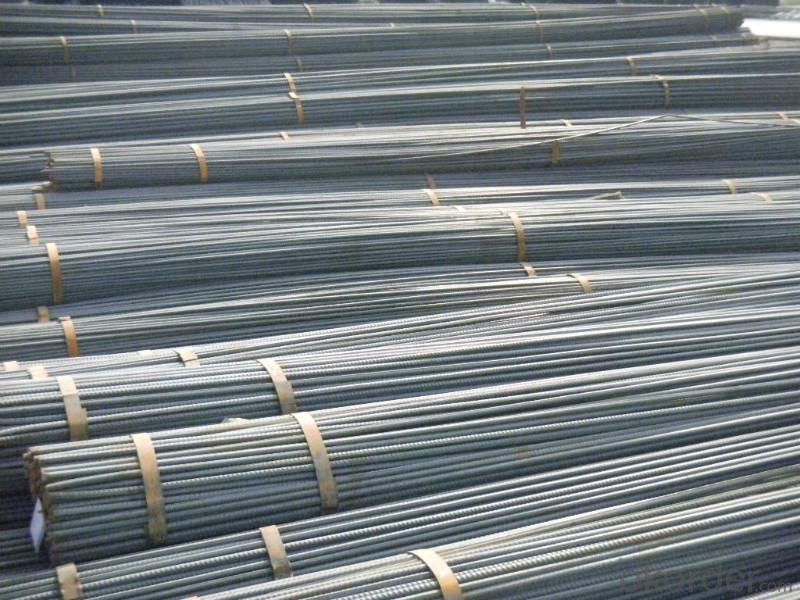

- Q: Can steel rebars be used in tunnels and underground structures?
- Tunnels and underground structures can indeed utilize steel rebars. These rebars are frequently employed in construction projects for the purpose of reinforcing concrete structures and providing added strength and durability. When it comes to tunnels and underground structures, where stability and load-bearing capacity are of utmost importance, incorporating steel rebars into the concrete walls, floors, and ceilings is a common practice to enhance their structural integrity. The utilization of rebars helps in distributing the load and resisting potential cracks or deformations that may arise from the pressure exerted by the surrounding soil or water. Furthermore, steel rebars possess resistance against corrosion, making them suitable for underground environments that may contain moisture and other corrosive elements. All in all, steel rebars play a vital role in the construction of tunnels and underground structures by ensuring their safety and longevity.
- Q: What are the advantages of using fiber-reinforced polymer (FRP) rebars over steel rebars?
- There are several advantages of using fiber-reinforced polymer (FRP) rebars over traditional steel rebars in construction projects: 1. Corrosion resistance: One of the main advantages of FRP rebars is their excellent resistance to corrosion. Unlike steel rebars, which are prone to rust and deterioration when exposed to moisture and chemicals, FRP rebars do not corrode. This property significantly increases the durability and lifespan of structures, particularly in harsh environmental conditions. 2. Lightweight: FRP rebars are significantly lighter than steel rebars, making them easier to handle, transport, and install. This lightweight characteristic also reduces the overall dead load of a structure, allowing for more efficient design and construction. 3. High strength-to-weight ratio: Despite being lightweight, FRP rebars have a high strength-to-weight ratio, meaning they can carry heavy loads while still maintaining their structural integrity. This property makes FRP rebars ideal for applications where weight reduction is desired without compromising on strength, such as in bridge decks and seismic reinforcement. 4. Non-magnetic and non-conductive: Unlike steel rebars, FRP rebars are non-magnetic and non-conductive. This feature is particularly advantageous in structures that require non-magnetic properties, such as MRI rooms in hospitals, or in situations where electrical conductivity needs to be minimized, such as in power plants or near electrical equipment. 5. Design flexibility: FRP rebars can be manufactured in various shapes and sizes, offering design flexibility and customization options to meet specific project requirements. They can be easily cut and shaped on-site, allowing for easy integration into complex geometries and curved structures. 6. Thermal compatibility: FRP rebars have a low coefficient of thermal expansion, which means they expand and contract at a similar rate to the surrounding concrete. This thermal compatibility minimizes the risk of cracking and ensures better long-term performance of the structure, particularly in areas with extreme temperature variations. 7. Excellent durability: FRP rebars exhibit excellent long-term durability, even in aggressive environments. They are resistant to alkalis, chemicals, and UV radiation, ensuring their performance and structural integrity over an extended period. 8. Environmental friendliness: FRP rebars are considered more environmentally friendly than steel rebars due to their minimal carbon footprint. They require less energy to produce and generate fewer greenhouse gas emissions during manufacturing. Additionally, FRP rebars are non-toxic and do not pose a threat to the environment during their lifespan or at the end of their service life. Overall, the advantages of using FRP rebars over steel rebars make them a viable alternative in various construction applications, offering improved durability, lightweight design, corrosion resistance, and enhanced structural performance.
- Q: What are the different types of steel rebars available for different applications?
- There are several types of steel rebars available for different applications, including carbon steel rebars, epoxy-coated rebars, stainless steel rebars, and galvanized rebars. Each type has its own unique properties and benefits, making them suitable for various construction projects based on factors like corrosion resistance, strength requirements, and environmental conditions.
- Q: Can steel rebars be spliced or joined together on-site?
- Yes, steel rebars can be spliced or joined together on-site. This is typically done using various methods such as welding, mechanical couplers, or lap splicing techniques, depending on the specific requirements and structural design.
- Q: How do steel rebars affect the durability of concrete structures?
- Steel rebars play a crucial role in enhancing the durability of concrete structures. By reinforcing the concrete, rebars help to increase its tensile strength, which is otherwise low compared to its compressive strength. This is crucial because concrete is highly effective in resisting compressive forces, but it is weak in withstanding tension or bending forces. When concrete structures are subjected to external forces like vibrations, wind, or earthquakes, the rebars absorb the tension and bending forces, preventing the concrete from cracking or collapsing. This ensures that the structure remains intact and stable. Without the presence of steel rebars, concrete structures would be more prone to damage and failure under such circumstances. Additionally, steel rebars also enhance the durability of concrete structures by preventing corrosion. When embedded in concrete, rebars act as a protective barrier against moisture and oxygen, which are primary agents that lead to the corrosion of steel. By preventing the penetration of these harmful elements, rebars significantly extend the lifespan of the concrete structure. Moreover, steel rebars provide dimensional stability to concrete structures. As concrete tends to shrink and expand due to temperature changes and moisture variations, the presence of rebars helps to counteract these movements. This prevents cracks from forming and ensures the structural integrity of the concrete. In summary, steel rebars greatly enhance the durability of concrete structures by increasing their tensile strength, preventing cracking and collapse, protecting against corrosion, and providing dimensional stability. Their presence is essential for constructing long-lasting and reliable concrete structures that can withstand various external forces and environmental conditions.
- Q: What is the difference between carbon steel and stainless steel rebars?
- The main difference between carbon steel and stainless steel rebars lies in their composition and corrosion resistance. Carbon steel rebars are made primarily of iron and carbon, while stainless steel rebars contain iron, chromium, and other alloying elements like nickel and molybdenum. Carbon steel rebars are more susceptible to corrosion compared to stainless steel rebars, especially in environments with high moisture or exposure to chemicals. Stainless steel rebars, on the other hand, have a higher resistance to corrosion due to the presence of chromium, which forms a protective oxide layer on the surface. This makes stainless steel rebars suitable for applications in harsh or corrosive environments, such as marine structures or concrete exposed to chloride ions. Additionally, stainless steel rebars have higher tensile strength and ductility compared to carbon steel rebars. This makes them more suitable for structural applications where high strength and durability are required. Overall, the choice between carbon steel and stainless steel rebars depends on the specific application and the level of corrosion resistance and strength needed.
- Q: How do steel rebars resist buckling in concrete structures?
- Steel rebars resist buckling in concrete structures due to their high tensile strength and ability to distribute and transfer loads. When concrete is subjected to compressive forces, the rebars provide tensile strength to counteract these forces. The ribbed surface of rebars enhances their bond with the surrounding concrete, ensuring effective load transfer. This reinforcement prevents the concrete from buckling under compressive stress, thereby enhancing the overall stability and strength of the structure.
- Q: Does the grade three thread steel with "E" have the same information price as the ordinary three grade thread steel? Is there a big difference?
- As far as I know, the price of information may not be divided into "E" and "E", but there are mandatory requirements on the standard. It is estimated that the price will not be much different.
- Q: How do steel rebars improve the load-carrying capacity of concrete?
- Steel rebars improve the load-carrying capacity of concrete by providing additional tensile strength. When concrete is subjected to heavy loads or forces, it tends to crack under tension. The inclusion of steel rebars within the concrete helps to counteract this weakness by absorbing the tensile forces and distributing them throughout the structure. This reinforcement enhances the overall durability and structural integrity of the concrete, allowing it to bear heavier loads without failing.
- Q: Are there any alternatives to steel rebars in construction?
- Yes, there are several alternatives to steel rebars in construction. Some common alternatives include fiber-reinforced polymer (FRP) rebars, basalt rebars, and glass fiber-reinforced polymer (GFRP) rebars. These alternatives offer advantages such as high corrosion resistance, lightweight, and improved durability while maintaining similar or better structural properties compared to steel rebars. However, the choice of alternative rebars depends on factors such as cost, specific project requirements, and local building codes and regulations.
Send your message to us
GR40 deformed steel bar for construction
- Loading Port:
- Tianjin
- Payment Terms:
- TT OR LC
- Min Order Qty:
- 25 m.t.
- Supply Capability:
- 10000 m.t./month
OKorder Service Pledge
OKorder Financial Service
Similar products
Hot products
Hot Searches
Related keywords
